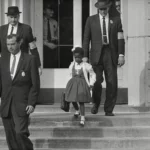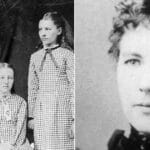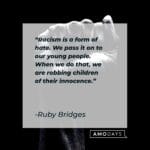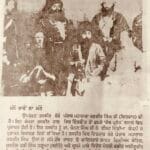The Quiet Strength Behind Ruby’s Bravery
We all recognize the iconic image of young Ruby Bridges, bravely facing hostility as she integrated an all-white school. But behind that powerful image stood another hero, often overlooked: her father, Abon Bridges. His story isn’t as widely told, but his unwavering support was fundamental to his family’s courage during this turbulent period in American history. Abon’s quiet strength played a crucial, though often unseen, role in Ruby’s journey. This article delves into Abon’s story, exploring his contributions and the sacrifices he made during this pivotal moment in the Civil Rights Movement. Don’t miss out on the intricate and profound exploration of themes such as love, time, and mortality in Venus Cupid Folly and Time, an enchanting masterpiece that will leave an indelible mark on your mind.
Born on January 20, 1931, in Tylertown, Mississippi, Abon grew up amidst the harsh realities of Jim Crow segregation. After serving in the Korean War, he married Lucille in 1953, and they started their family. In 1956, seeking better opportunities, they moved to New Orleans with their growing family, which by then included Ruby, born in 1954. Abon, a Korean War veteran, worked tirelessly as a gas station attendant and mechanic to provide for his family.
Life wasn’t easy, and he likely worried about the potential dangers and repercussions when Lucille insisted on enrolling Ruby in the all-white William Frantz Elementary School in 1960. This internal conflict probably reflected the complex feelings many Black parents grappled with at the time – a desire for better education for their children coupled with fear of the potential backlash. Some researchers suggest Abon’s initial hesitation may have stemmed from a protective instinct.
However, Abon ultimately supported Lucille’s decision. This wasn’t passive agreement but an active choice. He became a source of strength for his family, even as they faced angry mobs, insults, and threats. While Lucille walked Ruby to school each day under federal protection, Abon provided the essential foundation that allowed her to do so. He was the anchor, maintaining their home and providing a sense of normalcy amidst the chaos. Immerse yourself in the lyrical beauty of Walt Whitman’s When I Heard the Learn’d Astronomer as he reflects on the paradoxical nature of scientific knowledge and the allure of the unknown.
Abon’s contribution extended beyond simply being present. While the extent to which he directly influenced strategic decisions is debated, his role as provider afforded a degree of stability, enabling Lucille to focus on supporting Ruby. Some experts believe his military background may have influenced his resilience.
The Price of Courage: Abon’s Sacrifices and Legacy
Following Ruby’s integration, Abon lost his job, likely a direct consequence of their stand against segregation. Grocery stores refused to serve Lucille, and their sharecropping grandparents were evicted. These hardships placed immense strain on their marriage, leading to their separation in the late 1960s. Abon’s story is a powerful testament to the sacrifices made by ordinary individuals during the Civil Rights Movement.
Abon died in New Orleans on February 22, 1978, at the age of 47. The exact cause of death isn’t readily available. While he may not have been in the spotlight, his steadfast support was vital to Ruby’s success and the larger fight for equality. His story reminds us that monumental change often relies on the quiet acts of courage of countless unsung heroes.
Ruby’s Early Years: From Tylertown to New Orleans
Ruby Nell Bridges was born in Tylertown, Mississippi, on September 8, 1954. At age four, in 1958, her family moved to New Orleans seeking better opportunities. While New Orleans offered more than rural Mississippi, segregation was still deeply ingrained. Though young, Ruby likely experienced its effects, shaping her understanding of the world. Some historians suggest the Bridges family sought improved access to education and employment. This move reflects the resilience of many Black families during this period.
Ruby’s move placed her in the specific context where she would later make history. While the full extent of her experiences at that age remains unclear, they likely played a crucial role in shaping her understanding of the world. Her experiences navigating a segregated city and understanding her family’s hopes probably laid the foundation for her future courage.
The Bridges Family: Navigating the Ripple Effects of Change
Ruby is rightly celebrated, but what about her siblings? She had three younger brothers and a younger sister: Milton Jr., Malcolm, Patricia, and Sheila. While Ruby became the face of change, her siblings also lived through this challenging period, experiencing the ripple effects. They likely faced societal pressures and prejudice within their communities. Imagine being the sibling of the little girl escorted to school by federal marshals every day. They probably encountered questions and perhaps even hostility.
While Ruby endured isolation at William Frantz, her siblings probably faced their own challenges. They may have been targets of bullying or felt concern for Ruby’s well-being. Their family’s financial instability undoubtedly impacted them. The strain on their parents’ marriage, which ultimately ended in divorce, likely added another layer of complexity to their young lives.
Researchers are actively exploring the lives of individuals like Ruby Bridges’ siblings, whose experiences offer a nuanced understanding of the Civil Rights era. These untold stories are crucial for comprehending the full scope of segregation’s impact. While detailed information about Ruby’s siblings remains limited, their experiences are likely representative of many other African American families.
Areas for Further Exploration
- The impact of school integration on Black families in New Orleans.
- The role of unsung heroes in the Civil Rights Movement.
- The economic and social pressures faced by Black families during segregation.
- The lasting legacy of Ruby Bridges and her family’s courage.
By exploring these areas, we can gain a more complete understanding of the historical context and appreciate the untold stories of individuals like Abon Bridges, whose strength and resilience helped shape a more just and equitable society.
- Unlocking 2-Letter Words with U: The Definitive Guide - April 4, 2025
- Unlock Words with the Letters THREE: Top Unscramble Tools 2025 - April 4, 2025
- Master Scrabble: X & Z Words for High Scores - April 4, 2025
















